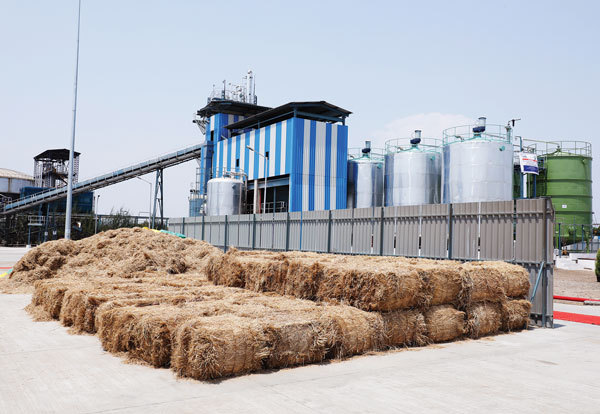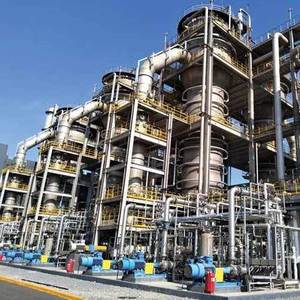Feedstock Flexibility




PHOTO: LANZATECH
May 13, 2019
BY Matt Thompson
A few well-known ethanol producers are developing cellulosic pathways that use feedstocks other than elements of corn. Enerkem, featured in the article on page 64, is one, focusing mostly in Canada, but a few others are working globally to produce fuels from new feedstocks, or improving on processes for existing ones.
Waste Gas
LanzaTech, a U.S.-based carbon capture and recycling company, produces cellulosic ethanol using waste gases from landfills, steel mills and other sources. The company has developed a gas fermentation process and has a commercial installation near Beijing.
“If you think about traditional fermentation, you’d use sugars and yeast to make beer or wine,” says Freya Burton, chief sustainability and people officer at LanzaTech. “We don’t use sugars, we use the gas, and we don’t use yeast, we use bacteria, and we’re not making wine, we’re making ethanol that can be blended in the fuel pool or converted into other products, and we’re making other chemicals as well.”
Burton says waste gas isn’t a common or simple feedstock because it’s dirty, requiring extra costs for cleaning and purifying. LanzaTech has been developing its process for many years, she says.
“We hope that it will become more widespread, but today, there are very few people who are using these gas streams,” she says.
The company’s commercial plant in China has been operating since May of 2018. “The ethanol’s been sold into the market in China,” Burton says. “They have blending mandates for road transport and, to date, we’ve produced around 6 million gallons of ethanol from the waste gases.”
For LanzaTech, China is an important market, Burton says. “We see immense potential from the blending side,” she says. “Last year, they increased the ethanol mandate to more provinces in China and there’s a definite focus on using waste and residues or nonfood resources, so cellulosic ethanol and also ethanol from waste carbon gases, for example. And so there’s a real definite push to get more of this into the market in China.”
LanzaTech is also working with Aemetis in California, which is exploring using the agricultural residue from nut farming to produce cellulosic ethanol through gasification.
Burton says the ethanol produced by LanzaTech is used for road vehicle fuel, but there are other uses as well. “Ethanol can be a building block for lots of other things—not just making ethylene, polyethylene and consumer goods, but also, we’ve developed a second-stage process that converts ethanol into a drop-in jet fuel.” She says jet fuel produced with LanzaTech’s process was used on a transatlantic flight last year. “We had enough to do a 5 percent blend last October,” she says. “And it was only a 5 percent blend because we just didn’t have the volume. So, that’s the next step is getting the volume from the commercial plants, or from any source of sustainable ethanol, and converting that into jet fuel.”
Forest to Fuels
Based in Finland, St1 is an energy company that operates primarily in the Nordic countries: Finland, Sweden and Norway, says Patrick Pitkänen, St1’s director of biorefining business development. In addition to producing biofuels, the company operates an oil refinery and retail stations in all three countries.
“We have both St1 brand stations and licensed Shell operations,” Pitkänen says. In Nordic countries, many energy companies deal in both fossil fuels and biofuels. “At least in the Nordic, all the players, or most of the players, are involved in both,” he says. “We have a good understanding about the fact that we have to change business.”
St1 began producing ethanol 12 years ago, from food industry waste, Pitkänen says. The company now has four operating plants in Finland, as well as one in Sweden.
The company is now looking to expand into wood feedstocks, with a demonstration plant in Finland. “When we started from food industry waste and sugars and starch from bakeries and so on, we realized that we don’t have the feedstocks or the volume,” he says. As much of the land in Nordic countries is forested, Pitkänen says the company explored using waste from the sawmills and forest industries as a feedstock for producing ethanol. “We are using sawmill residues and we are certified to operate on soft wood,” he says. “Pine and spruce are the major species in Nordic countries and we are using these. I believe that very few players are on the soft wood.”
In addition to producing ethanol, St1 is also focused on coproducts, such as lignin. “Our efforts are related today to the process itself, but also to the side products,” Pitkänen says.
He says St1 also has a pilot plant in Thailand using feedstock from the local food industry.
And Chempolis, as part of a joint venture with Fotum and Numaligarph Revinery Ltd., is constructing a plant in Assam, India, that will produce ethanol from bamboo. Construction on the plant is expected to begin in 2020, and in addition to ethanol, the plant will produce furfural, acetic acid and biocoal.
Circular Bioeconomy
Praj, based in India, has operations around the world. Pramod Chaudhari, executive chairman of Praj, says the technology developed by the 35-year-old company is the basis for many plants across the globe. “If you go to a country like Columbia, you’ll find practically 100 percent of plants are based on our technology,” he says. “In Thailand it is more than 60 percent.” He adds the company’s goal is to help create a circular bioeconomy.
One of the ways it hopes to do that is through its cellulosic ethanol technology: Enfinity. Enfinity allows plants to produce cellulosic ethanol from biomass feedstocks, such as rice and wheat straw, bagasse, corn cobs and stover, among others. Following the completion of a successful pilot plant, Praj in 2017 built a second-generation demonstration plant, which Chaudhari says was a logical extension of the company’s first-generation ethanol technology.
“The 2G biorefinery demo plant is in a field next to a sugar mill, so we get different types of inputs from the sugar mill,” Chaudhari says. “And it is quite flexible to accommodate a variety of feedstocks, whether it be bagasse or rice straw or wheat straw and different batches of palm oil. Most of the feedstocks can be tested there.”
Chaudhari says Praj has four contracts for commercial-scale plants in India. He adds that the first plant should be operational by the end of 2020 or early 2021. Chaudhari says the company is hoping to bring its technology to Europe, the U.S. and other parts of the world.
That scale-up, from pilot to commercial plants, was possible, in part, thanks to Praj’s Research and Development center, Praj Matrix, which Chaudhari says “is the major backbone of our activities.”
Praj is also moving into the renewable gas and renewable chemicals markets. “The biogas business the last so many years has been a part of our wastewater treatment solution, to the ethanol plant,” Chaudhari says. “But now it is getting its own standing, its own recognition as renewable fuel.”
Praj is working with Gevo, a U.S.-based company, to produce jet biofuels. “We are trying to adopt their technology to tropical feedstocks like molasses and also agri-residue,” Chaudhari says. Praj hopes to produce isobutanol using juice, syrup and molasses as feedstocks.
A few other projects are coming up here and around the world that plan to use crop residues as feedstock. Expected to break ground in 2019, the New Energy Spirit Biomass Refinery near Spiritwood, North Dakota, is projected to use Inbicon technology to produce 16 MMgy of cellulosic ethanol. It will be the first commercial-scale implementation of the Danish technology in the U.S. The plant will use wheat straw, and possibly corn stover, as its feedstock, and its ethanol will be sold to the California market to take advantage of the state’s Low Carbon Fuel Standard, the plant’s developers say. In addition to ethanol, the plant will also produce fuel pellets from lignin. The project is financed using a Danish loan guarantee through Denmark’s export credit agency, the EKF.
In 2018, Clariant celebrated the groundbreaking of its sunliquid plant in Romania. The plant’s feedstock will include wheat and other cereal straw from local farmers. Production at the 16.74 MMgy plant is expected to begin in 2020 and is the first deployment of the sunliquid technology.
Also in North Dakota, Red River Biorefinery began construction of its cellulosic plant outside of Grand Forks in August. The plant will use technology from Biotechnika, a European company, to convert its feedstock—sugar beet tailings, and pasta and potato processing waste—into cellulosic ethanol. The technology is in use in Poland.
And recent D3 renewable identification number reports from the U.S. EPA reflect more imported cellulosic ethanol, signaling that two Brazilian plants might be producing more this year. Raizen Energia has been producing from sugarcane bagasse and straw since 2014. The plant uses Iogen technology and is located near a sugarcane mill in Piracicaba, São Paulo. GrandBio’s cellulosic ethanol plant in Alagoas uses sugarcane straw and bagasse. The plant began producing cellulosic ethanol in 2014.
Finally, the 13 MMgy Beta Renewables cellulosic ethanol plant in Crescentino, Italy, was purchased last year in a large acquisition of bankrupt parent company Mossi & Ghisolfi by Eni subsidiary Versalis. Versalis is a chemical producer and says it plans to launch plant operations to continue producing ethanol from ag waste.
Author: Matt Thompson
Associate Editor, Ethanol Producer Magazine
701.738.4922
mthompson@bbiinternational.com
Advertisement
Advertisement
Related Stories
CARB on June 27 announced amendments to the state’s LCFS regulations will take effect beginning on July 1. The amended regulations were approved by the agency in November 2024, but implementation was delayed due to regulatory clarity issues.
The USDA’s National Agricultural Statistics Service on June 30 released its annual Acreage report, estimating that 83.4 million acres of soybeans have been planted in the U.S. this year, down 4% when compared to 2024.
SAF Magazine and the Commercial Aviation Alternative Fuels Initiative announced the preliminary agenda for the North American SAF Conference and Expo, being held Sept. 22-24 at the Minneapolis Convention Center in Minneapolis, Minnesota.
Saipem has been awarded an EPC contract by Enilive for the expansion of the company’s biorefinery in Porto Marghera, near Venice. The project will boost total nameplate capacity and enable the production of SAF.
Global digital shipbuilder Incat Crowther announced on June 11 the company has been commissioned by Los Angeles operator Catalina Express to design a new low-emission, renewable diesel-powered passenger ferry.
Upcoming Events










